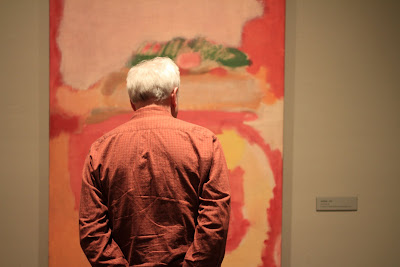Entrance to the Portland Rothko Exhibit (left), Rothko Self-Portrait –1936 (middle), Hierarchical Birds – 1934 (right)
Watching People Watching Rothko at the Portland Art Museum, May 2012
The exhibition Mark Rothko was at the Portland Art Museum from Feb 18 to May 27, 2012. We caught the exhibition in its last few days. The exhibition featured 45 works by the Russian-American artist Mark Rothko (1903 - 1970). Rothko (born Marcus Yakovlevich Rothokowitz) emigrated from Russia (now Latvia) at the age of 10 and came to Portland, Oregon. He would return to Portland several times throughout his life. Rothko’s first museum exhibition was hosted by the Portland Art Museum in 1933-1934. And, the recent exhibition is the first retrospective of his work staged in Portland.
The exhibit was compact, with just a few interconnected rooms, but it did not disappoint. In the exhibit, Rothko’s works were arranged chronologically so you could really see how his style changed, from figurative, to surrealism, to transitional “multiform” paintings, and finally to his “late” period of stacked, translucent rectangular forms.
We were unfamiliar with some of Rothko’s early work, in particular his subway series with their attenuated figures and bleak settings. And even more surprising were the works in the early 1940s that deal with myth. An exhibition description described this Rothko period as
1941-1943 “Works closely with [Adolph] Gottlieb to develop an aesthetic based on Greco-Roman and Judeo-Christian myth. They share an interest in Jungian and eternal symbols, the power of myth, and psychological content in art.”
It was fun to see and perhaps would have been pleasing for Rothko to see people standing before his late period works, lost in the expanse of color. There is something undeniably powerful about the floating color fields. In the book Mark Rothko by Jeffrey Weiss et al., Rothko is reported on one occasion to have advocated a viewing distance of eighteen inches. For some of Rothko’s works the effect can be like getting lost in the color.
After the exhibition we purchased the book The Artist’s Reality - Philosophies of Art. It is a collection of essays by Rothko discovered in 1988 and eventually organized and edited by his son Christopher Rothko and published in 2004. The essays are estimated to have been written in between 1940 - 1941. In the essays we get a peek at Rothko’s ideas on art, beauty, myth, and more. We are warned in the introduction that “Rothko has no patience for anything that did not aspire to the highest ideals.” and “[h]is own feeling of deprivation adds an extra bite to his words.” For example, in the essay Art as a Form of Action, he states: “In fact, the man who spends his entire life turning the wheels of industry so that he has neither time nor energy to occupy himself with any other needs of the human organism is by far a greater escapist than the one who developed his art.” (We read this as we sat, early one morning before heading off to one of those wheels.)
Honestly, the thoughts expressed in the essay are beyond us and are for scholars of Rothko. However, the introduction is a good read and filled in some of the background we were missing. We also suggest watching Simon Schama’s Power of Art (2007) Rothko episode.
In the end, our reaction to Rothko’s late pieces remains the same as the day we walked into the Rothko Rom at the Tate Gallery: wonder, sadness, hope, peace, agitation - emotion and feeling - not really thinking, but feeling and emotion. Yes, at times, the colors are pleasing to look at but that’s more an aside. Hopefully, Rothko would be pleased. Schama in the Rothko episode says this of the viewer’s reaction: “emotionally stirring, sensually addictive”.
To visit the exhibition, we took a day trip to from Seattle to Portland, following the bone-rattling and noisy Interstate-5 for a couple of hours each way. A bright spot was finding a nice French restaurant in Olympia called La Petite Maison where we ate at on the way back.
Milton Avery - Bathers, Coney Island – 1934, An Important Influence on Rothko (left), In the Middle of a Red Canvas (right)
Entrance to a Subway – 1938 (left), Subway c. - 1937 (right)
Three Rothko Works Showing the Progression of His Work in One View (left), Untitled 1941-2 (right)
The Artist’s Reality – Philosophies of Art Front (left), Back (right)











No comments:
Post a Comment
All comments go through a moderation process. Even though it may not look like the comment was accepted, it probably was. Check back in a day if you asked a question. Thanks!